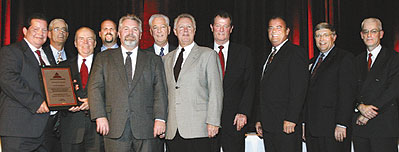
At the CURT ceremony honoring the Helmets to Hardhats program are,
left to right, President Edward C. Sullivan of the AFL-CIO Building
and Construction Trades Department (BCTD), CURT President Bill Tibbitt
of Johnson & Johnson, Executive Director Matthew Caulfield of
Helmets to Hardhats, Director Dan Caulfield, Helmets to Hardhats,
Secretary-Treasurer Joe Maloney of BCTD, IBEW International President
Edwin D. Hill, Ironworkers General President Joseph J. Hunt, IBEW
International Secretary-Treasurer Jerry J. O’Connor, Carl
Murphy of BCTD, CURT Past President Steve Satrom of Air Products
& Chemicals and Norbert Young of McGraw-Hill.
In One Year, Helmets to Hardhats Attracts 13,000 Vets as Applicants
Lawrence Chavez of IBEW Local 5, Pittsburgh, Pennsylvania,
is one of the 13,000 returning U.S. military personnel who sought
a civilian job by registering his skills with the Helmets to Hardhats
program. It has worked out exceedingly well for him.
“Today, as a union journeyman wireman, I don’t have
to keep proving my abilities to each contractor I work for,”
Chavez says. “If I want I can work at any local union in the
country on just the strength of my union ticket.”
Even though the congressionally funded Helmet to Hardhats (H2H)
program is only a year old, it has already been named the 2003 winner
of the “workplace development award” by the Construction
Users Roundtable (CURT). CURT co-sponsors the Helmets to Hardhats
program with the 15 unions in the AFL-CIO Building and Construction
Trades. CURT membership includes construction contractors and customers
along with the unions.
About 82,000 contractors participate in Helmets to Hardhats, whose
executive director, Matt Caulfield—a retired Marine major
general—says the average Helmets to Hardhats cost for placing
a candidate is only about 20 percent of the current construction
industry average hiring cost. He credits the pre-screening of applicants
and the use of the Internet—with 4.5 million hits during the
first year—with a major role in the success of registering
13,000 applicants. Bechtel, Disney and the Tennessee Valley Authority
are among the latest companies to join the program, Caulfield said.
Chavez says that once the local labor board alerted him to Helmets
to Hardhats, “before I knew it, I was taking the journeyman
test, which I passed and was admitted.” And indenturing brand
new electricians as highly qualified as Brother Chavez is termed
by International President Edwin D. Hill as one of the goals of
the IBEW’s aggressive new organizing program.
“We are simply not going to rest until we know that every
local union has removed all artificial barriers to IBEW membership,”
Hill said last fall in announcing the expanded program. “And
Helmets to Hardhats is an exemplary way for us to continue expanding
our membership. There is no one we would rather have to help us
meet the needs of a constantly changing industry than those brave
men and women who have been defending us in these perilous times.”
After 20 years in the military, Local 5’s Lawrence Chavez
says the wide variety of assignments served to attract him to the
IBEW. “The entire spectrum of the craft is at your disposal,”
Brother Chavez says. “Today I may be punching down CAT wire
and connectorizing fiber optical centers. Tomorrow, I may be doing
high voltage connections on a multistory skyscraper or designing
UPS systems for a hospital or a bank. We do it all.”
More information on how local unions can participate in the program
is available at www.helmetstohardhats.org.

|
IBEWCURRENTS
March 2004 IBEW
Journal |
